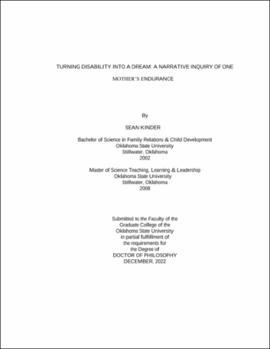| dc.contributor.advisor | Curry, Katherine | |
| dc.contributor.author | Kinder, Sean | |
| dc.date.accessioned | 2023-09-22T18:31:54Z | |
| dc.date.available | 2023-09-22T18:31:54Z | |
| dc.date.issued | 2022-12 | |
| dc.identifier.uri | https://hdl.handle.net/11244/339614 | |
| dc.description.abstract | Research has indicated that, as of 2017, 18.7 percent of individuals who had a disability held employment, as opposed to 65.7 percent without a disability (U.S. Bureau of Labor Statistics, 2018). Despite the passage of the Americans with Disability Act of 1990, this indicates that possible discrimination of individuals with disabilities still exists. This anomaly could be the result of misunderstandings of those who are nondisabled of actual limitations of individuals with disabilities and of their capacity to contribute to society and to the workforce. It is difficult for individuals to perceive the potential of individuals with socially defined disabilities (Marchioro, 2000). | |
| dc.description.abstract | There are nondisabled people that can inspire and motivate potential in those individuals to accomplish goals and attempt tasks beyond what was perceived as impossible. Critical Disability (CDT) and Authentic Leadership (AL) Theories are theoretical frameworks utilized in this qualitative narrative inquiry to tell the story of a mother’s (Jane) journey of raising two children with disabilities. Through the examination of her critical life events, this study seeks to provide an understanding of how she inspired individuals with disabilities to reach potential beyond the limitations they experience because of their disability. | |
| dc.description.abstract | Due to their disabilities, barriers in school placement and expectations that underestimated their capacity and potential (Goodley, Hughes, & Davis, 2012) were experienced. Jane also experienced barriers from the hearing impaired community including non-acceptance of cochlear implants and resistance to involvement of hearing abled individuals in the deaf community. She developed into a strong advocate for hearing impaired individuals and developed an educational platform to advance their opportunities. Her approach to the hearing impaired community stands in stark contrast to typical societal perceptions of the disabled. CDT has limitations in explaining the development of Jane as an advocate for hearing impaired individuals. Therefore, AL provides a lens to understand her leadership role that evolved. Further, AL explains Jane’s unique characteristics and positionality to lead individuals in the deaf community toward growth and development. Among the findings of this study were that Jane earned credibility as a leader and disability advocate. | |
| dc.format | application/pdf | |
| dc.language | en_US | |
| dc.rights | Copyright is held by the author who has granted the Oklahoma State University Library the non-exclusive right to share this material in its institutional repository. Contact Digital Library Services at lib-dls@okstate.edu or 405-744-9161 for the permission policy on the use, reproduction or distribution of this material. | |
| dc.title | Turning disability into a dream: A narrative inquiry of one mother’s endurance | |
| dc.contributor.committeeMember | Loffi, Jon | |
| dc.contributor.committeeMember | Harris, Ed | |
| dc.contributor.committeeMember | Hammer, Tonya R. | |
| osu.filename | Kinder_okstate_0664D_17914.pdf | |
| osu.accesstype | Open Access | |
| dc.type.genre | Dissertation | |
| dc.type.material | Text | |
| dc.subject.keywords | administration | |
| dc.subject.keywords | disability | |
| dc.subject.keywords | education | |
| dc.subject.keywords | narrative inquiry | |
| dc.subject.keywords | policy | |
| dc.subject.keywords | qualitative | |
| thesis.degree.discipline | Education Leadership and Policy Studies | |
| thesis.degree.grantor | Oklahoma State University | |
